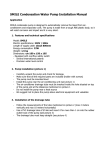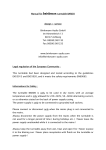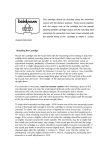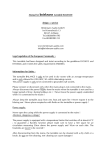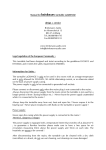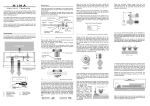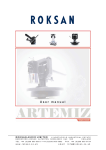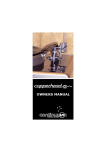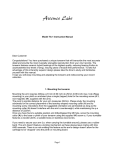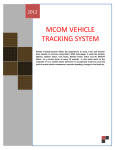Download User Manual - Brinkmann audio
Transcript
Mounting, Setup and Operations Instructions for brinkmann Tonearm 10.5 Mark a point on the tone arm board at a distance of exactly 243 mm from the center of the turntable spindle. Use a compass to lightly draw two circles around this point, one with a diameter of 20 mm and another with a diameter of 24 mm. Mark three points on the outer circle equidistant to each other at 120° angles as shown. Drill out the 20 mm circle using a woodcutting bit. Bevel the upper edge of the drilled hole slightly towards the center so that the top plate of the mounting assembly with its rounded seam at the mounting sleeve underneath will fit flush on the tone arm board. Next drill out the three marked points on the outer circle for M3 size machine screws. Insert that when two must the mounting assembly into the 20 mm diameter hole making sure the setscrew for fixing the tone arm in the mounting sleeve is easily accessible. The slotted mounting plate and sleeve act like a clamp the setscrew is tightened. To clamp the sleeve it is necessary that the M3 mounting screws to the left and right of the slot allow some movement. They are therefore supplied with copper washers and not be fixed too tightly. The third mounting screw opposite the slot is tightened without a washer. Insert the tone arm into the mounting sleeve. With the arm sitting firmly in the tone arm rest align it perpendicular to the front of the turntable. As long as the setscrew in the mounting plate has not been tightened the arm shaft in the sleeve can be moved up and down using the height adjustment screw (10). The internal wires from the tone arm must be connected to a pair of either RCA or XLR terminals with the following color-coding: Red = right channel positive Green = right channel negative White = left channel positive Blue = left channel negative The copper-colored fifth litz wire is for grounding the arm. It is connected to the tone arm base and the ground lead to the preamp. With its beveled side pointing forward slide the counter weight (2) onto the rear of the tone arm. The counter weight consists of the beveled base weight and two discs of different thickness and weight, which move on a threaded shaft. The tracking force of the stylus can be adjusted by simply moving the counter weight back or forth. The position of the counter weight can be fixed with a small setscrew in the base weight. When using a very heavy cartridge the two discs may have to be moved all the way back. With very light cartridges you may have to remove one or the other of the weight discs. When using both discs make sure that they are screwed tightly against each other to avoid resonance. Mounting the Cartridge Mount the cartridge into the head shell (1) with the mounting screws sitting in about the middle of the slotted mounting holes in the head shell. Make sure that the sides of cartridge and head shell run parallel to each other. We recommend using an adjustment template, preferably a Dennesen Geometric Soundtracktor. Move the tone arm with the height adjustment screw (10) until it is parallel to the turntable, and then align the stylus according to the markings on the template (Geopoint). The tracking force at the stylus tip should be between 1.8 and 2 g, not more or less if possible. More about that in the chapter on the counter weight. The antiskating adjustment (7) at the tone arm should not be set at this point. To adjust azimuth take a strong magnifying glass (at least 10X) and look at the stylus exactly from the front. The triangle of the diamond stylus tip should point straight down. If a correction is necessary and the cartridge allows this procedure, exercise extreme caution when inserting a piece of 0.8 mm diameter steel wire into the small lateral drill hole in the round rod that presses the transducer onto the rubber damper. By turning the rod in minute increments (without loosening the tiny set screws at the cartridge) you also turn transducer and cantilever and with it the diamond tip. To adjust the horizontal tracking angle (HTA) loosen one of the two mounting screws on top of the head shell enough to turn the cartridge in minute increments inward or outward. To check the result you must re-tighten the screw every time. Check by playing a very familiar tune about one to two centimeters in from the beginning of the LP. Most revealing would be a solo voice recorded in the center of the stereo image. If the voice is slightly to the left of center the cartridge should be turned ever so slightly inwards towards the center spindle. The increments may be so slight that the naked eye could not detect any change. If the sound gets too soft and the image too hazy the cartridge as a whole should be moved slightly forward. Consequently, if the sound gets brittle it should be moved slightly back. These adjustments should be checked again after the cartridge is broken in. Please note that the setting for antiskate will also slightly influence HTA. Hence, changing the antiskating force amounts to a small adjustment in HTA. Now adjust the vertical tracking angle (VTA). If you determine that after the correct setting of the horizontal tracking angle highs are too dull and bass is too plump and uncontrolled the VTA must be increased. You do that by raising the tone arm in the mounting sleeve, again in very small increments. If the sound becomes glassy you’ve raised the arm too much. At the correct setting highs sound natural and transparent and bass runs sound bouncy and sonorous. To underscore the point again: Any adjustments which change the basic geometric setting that was determined by using a template or a Dennesen Soundtracktor should be done with great care and in very small increments. Otherwise it is easy to loose track and get further and further away from the desired results. The rest on the tone arm lift can be height-adjusted by loosening the setscrew (11) and raising or lowering it. If the upward extension is insufficient, the whole lift (5) may be raised by loosening the hex screw at the front of the plate that holds the lift. The antiskating force is set magnetically with a magnetic ring (6). It is magnetized at a 120° angle and it is set with an adjustable pin magnet (7). The magnets try to move the arm back into its resting position and thus creating a counter force compensating the skating force. Screwing the pin magnet further in increases the antiskating force. To find the correct setting it is best to use a test record containing sine wave pulses or music recorded with increasing peak velocity. If at higher velocity distortion occurs in one channel only, move the antiskating adjustment until the distortion occurs in both channels at the same time. These adjustments only make sense after azimuth, HTA and VTA have been set correctly. If the desired antiskating force exceeds the maximum magnetic force it is likely that one or more of the other settings are incorrect. Please note that setting the antiskating force could also slightly change the HTA. Tonearm effective mass at the slotted mounting holes: 10 gr. , weight completely (without cartridge) : 280 gr. weight only counterweight : 150 gr. brinkmann Im Himmelreich 13 88147 Achberg Germany tel: 08380 981195 fax: 08380 981233 mail: [email protected]



